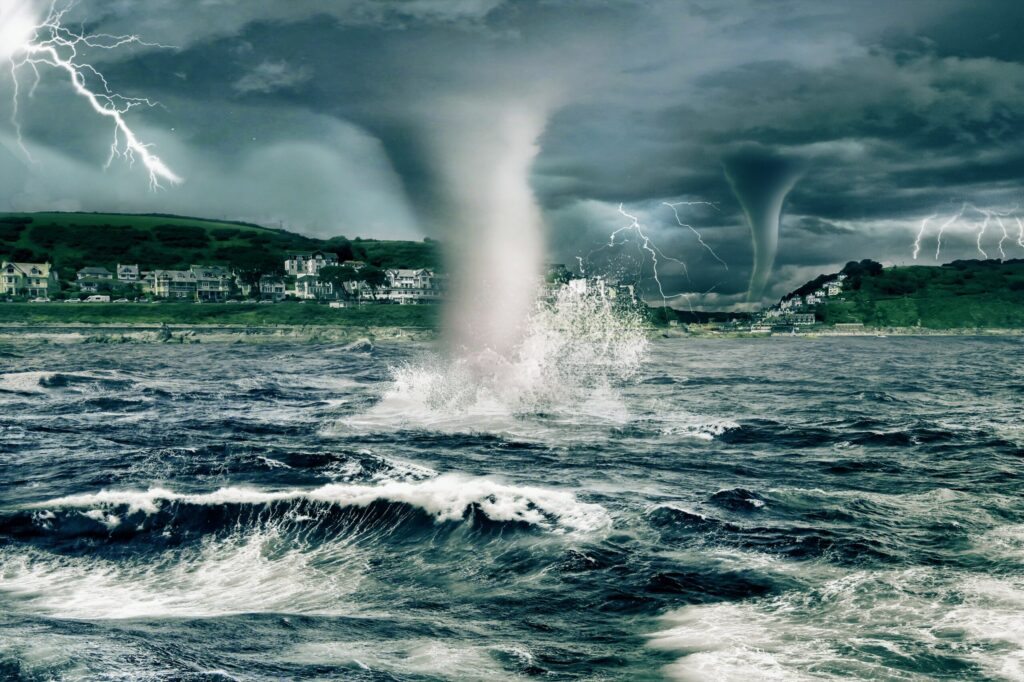

Extreme weather refers to severe and potentially dangerous weather conditions such as thunderstorms, blizzards, and high winds that can threaten life and property. It is important to prepare for extreme weather in order to minimize its impact and protect oneself and one’s belongings.
This article will provide an overview of the different types of extreme weather, why it is important to be prepared, and what steps to take in handling extreme weather situations.
Check out this Youtube video: Whether you’re into bushcraft and survival training or just want to be better prepared for extreme weather, this video has valuable tips and skills to help you handle any outdoor emergency.
Understanding Extreme Weather
Explanation of different types of extreme weather (e.g. hurricanes, tornadoes, blizzards)
Extreme weather encompasses various phenomena, such as hurricanes, tornadoes, and blizzards. Hurricanes, known for their destructive winds and heavy rainfall, originate over warm ocean waters.
Tornadoes, characterized by their violently rotating columns of air, form in severe thunderstorms. Lastly, blizzards bring heavy snowfall, strong winds, and low visibility, posing significant hazards to communities.
Statistics on the frequency and impact of extreme weather events
Statistically, extreme weather events have shown an alarming increase in frequency and impact. According to the Intergovernmental Panel on Climate Change (IPCC), the frequency of hurricanes and severe storms has surged in recent decades, resulting in widespread devastation and economic losses.
Additionally, data from the National Oceanic and Atmospheric Administration (NOAA) highlights a concerning trend of intensifying blizzards and prolonged heatwaves, exacerbating the risks associated with extreme weather.
Historical facts about memorable extreme weather events
Historical accounts reveal numerous memorable extreme weather events that left a lasting impact. The Great Galveston Hurricane of 1900 stands as one of the deadliest natural disasters in US history, claiming thousands of lives.
Another notable event, the Tri-State Tornado of 1925, tore through three states, leaving widespread destruction and a tragic death toll. Furthermore, the 1993 Superstorm, also known as the “Storm of the Century,” paralyzed the eastern United States with unparalleled snowfall and powerful winds, causing extensive damage.
Preparing Your Home
Steps for securing your home against extreme weather (e.g. reinforcing windows, clearing gutters)
To secure your home against extreme weather, start by reinforcing windows with storm shutters made of high-impact glass or metal. Additionally, clearing gutters and securing outdoor objects like gutters can prevent damage during storms.
Examples of home preparations for specific types of extreme weather
For hurricanes, reinforce garage doors, fortify your roof and fencing, and ensure outdoor objects are secure. In colder climates, gather blankets, pillows, warm clothing, and locate a first aid kit and essential medical supplies.
Importance of having emergency supplies and a family communication plan
Having emergency supplies such as blankets, pillows, and a first aid kit is crucial for surviving extreme weather events. Additionally, a family communication plan is vital for staying connected and ensuring everyone’s safety during emergencies.
Handling Extreme Weather on the Road
Tips for driving in extreme weather conditions
- Plan your trip ahead of time, anticipating delays and increased stress.
- Reduce your speed and leave plenty of space between you and the vehicle in front of you.
Examples of emergency kits to keep in your car
| Essential Items | Additional Gear |
|---|---|
| Blankets | Flashlight and batteries |
| First aid kit | Multi-tool and gloves |
| Non-perishable snacks | Ice scraper and shovel |
Importance of staying informed about road conditions and weather forecasts
- Being aware of road conditions and weather forecasts can help you make informed decisions about when to travel and which routes to take.
Staying Safe During Extreme Weather
Dressing appropriately for different types of extreme weather
Layering: When preparing for extreme weather, layer your clothing to retain warm air close to your body. Incorporate a warm jumper or cardigan over your attire and a thermal layer underneath for optimal insulation.
Importance of limiting exposure to extreme cold or heat
Warm Fabrics: Opt for clothing made of wool, cashmere, or fleece to ensure excellent insulation and warmth during frigid weather conditions. Additionally, avoid cotton fabrics as they do not hold body heat well and absorb moisture, leading to discomfort in extreme cold.
Examples of staying safe during thunderstorms, lightning, and strong winds
Thunderstorm Safety: To ensure safety during thunderstorms, it is crucial to prepare and establish an emergency plan. It is advisable to stay away from windows and doors, as strong thunderstorms can cause flying debris that may pose a significant threat.
| Weather Condition | Safety Precautions |
|---|---|
| Thunderstorms | Stay away from windows and doors |
| Prepare and establish an emergency plan | |
| Avoid using corded telephones during the storm |
Health Considerations During Extreme Weather
Impact of extreme weather on physical health and mental well-being
Extreme weather events such as heatwaves and hurricanes can have severe impacts on physical health. Heatwaves can lead to heat exhaustion and heatstroke, while hurricanes can cause physical injuries and trauma.
These events can also take a toll on mental well-being, leading to increased anxiety, depression, and post-traumatic stress disorder (PTSD) among affected individuals.
Tips for staying healthy during and after extreme weather events
To stay healthy during extreme weather events, individuals should prioritize staying hydrated, seeking shelter in safe locations, and following evacuation orders if necessary. After the event, it’s crucial to avoid contaminated water sources, prevent insect bites, and monitor any respiratory symptoms due to air pollution caused by the weather event.
Seeking emotional support and counseling is also essential for coping with the aftermath and potential trauma.
Importance of seeking medical attention when necessary
Seeking prompt medical attention during extreme weather events is critical, especially for physical injuries, dehydration, and symptoms of heat-related illnesses. It’s vital to watch out for signs of distress, such as difficulty breathing, chest pain, and severe anxiety, and seek professional medical help when experiencing these symptoms to avoid potential health complications.
Caring for Pets and Livestock
Examples of how to care for animals during extreme weather
Example 1: Providing ample shading and water sources is crucial during extreme heat. This includes setting up shaded areas, portable fans, and regularly refilling water troughs.
Example 2: During extreme cold, extra bedding like straw or hay can be used to provide insulation for animals in outdoor shelters. Windbreaks and insulated jackets for pets can also help in such conditions.
Importance of including pets and livestock in emergency plans
Importance: It is vital to include pets and livestock in emergency plans as they are completely reliant on their owners for safety and care during critical situations. Pets and animals are valuable assets and need to be considered in disaster preparedness efforts.
Tips for keeping animals safe during various types of extreme weather
Tip 1: Ensure that all dogs and cats have collars with up-to-date identification, making it easier to reunite them with their owners in case they get separated during extreme weather.
Tip 2: Creating a pet emergency kit and making evacuation plans in advance can significantly contribute to ensuring the safety and well-being of animals during natural disasters.
Rebuilding and Recovery
Steps for recovering after an extreme weather event
- Assess the damage and prioritize safety measures to prevent further harm.
- Seek assistance from local authorities or disaster relief organizations for immediate aid.
- Document the extent of the damage for insurance claims and legal purposes.
- Start the cleanup process by removing debris and ensuring structural stability.
- Address emotional well-being by seeking support from family, friends, or mental health professionals.
Examples of community resources for rebuilding and recovery
| Community Resources |
|---|
| 1. Local shelters providing temporary housing for those displaced by the disaster. |
| 2. Food banks and distribution centers offering free meals and essential supplies. |
| 3. Volunteer organizations assisting with debris removal and rebuilding efforts. |
| 4. Counseling services and support groups for individuals dealing with trauma and loss. |
Importance of mental health support during the recovery process
- Mental health support plays a crucial role in helping individuals cope with the emotional toll of rebuilding after a catastrophic event.
- Counseling services, group therapy, and community support networks can provide vital emotional and psychological aid.
- Addressing mental health needs during recovery promotes resilience and aids in the rebuilding of a strong, unified community.
Government and Community Response
Importance of government and community preparedness and response to extreme weather
Government and community preparedness and response to extreme weather are crucial for minimizing the impact of severe weather events on public safety and infrastructure. By having well-established emergency response plans and resources in place, authorities can swiftly address the challenges posed by extreme weather, ensuring the well-being of the population and the continuity of essential services.
Examples of government initiatives for extreme weather preparedness
One notable example of a government initiative for extreme weather preparedness is the “Climate Change and Adaptation to Extreme Weather Infrastructure” program launched by the Government of Canada. This initiative allocates substantial funding, up to $10.5 million, to enhance infrastructure resilience and adaptability in the face of extreme weather conditions.
Additionally, the “Extreme Weather Preparedness for Agriculture Program” supports farmers and ranchers, aiming to increase their preparedness and resilience to extreme weather events.
| Government Initiative | Description |
|---|---|
| Climate Change and Adaptation to Extreme Weather Infrastructure | Provides up to $10.5 million in funding to enhance infrastructure resilience to extreme weather. |
| Extreme Weather Preparedness for Agriculture Program | Supports farmers and ranchers in increasing their preparedness and resilience to extreme weather events. |
Importance of community support and collaboration during extreme weather events
Community support and collaboration play a vital role during extreme weather events, fostering the creation of collaborative networks among various stakeholders. These networks facilitate the exchange of critical information, resources, and expertise before, during, and after extreme weather events.
Moreover, community-based adaptation enhances collective action, cooperation, and mutual support, promoting resilience and making a significant difference in the overall response to extreme weather challenges.
Climate Change and Extreme Weather
Discussion of the connection between climate change and the frequency/severity of extreme weather events
Climate change has been directly linked to the increased frequency and severity of extreme weather events. As global temperatures rise due to human-caused greenhouse gas emissions, the climate becomes more volatile, leading to intense heatwaves, storms, and flooding.
The connection is evident in scientific studies, showing that extreme weather events are becoming more frequent and intense, posing significant challenges to communities worldwide.
Examples of climate change mitigation and adaptation strategies
Mitigating climate change involves reducing and stabilizing greenhouse gas levels in the atmosphere. Strategies include transitioning to renewable energy sources, promoting energy efficiency, and implementing carbon capture and storage technologies.
On the other hand, adaptation strategies focus on adjusting to the current and expected impacts of climate change. Examples include building resilient infrastructure, improving water management systems, and implementing early warning systems for extreme weather events.
Importance of addressing climate change for long-term handling of extreme weather
Addressing climate change is crucial for ensuring the long-term resilience and preparedness for handling extreme weather events. By mitigating climate change, we can limit the severity of future extreme weather events and reduce their impact on communities and ecosystems.
Additionally, investing in adaptation measures ensures that societies can effectively cope with the current and future challenges posed by extreme weather, safeguarding lives and livelihoods.
| Mitigation Strategies | Adaptation Strategies |
|---|---|
| Transition to renewable energy sources | Build resilient infrastructure |
| Promote energy efficiency | Improve water management systems |
| Implement carbon capture and storage technologies | Establish early warning systems for extreme weather |
The connection between climate change and extreme weather events is undeniable, and addressing it through both mitigation and adaptation strategies is crucial for building resilience and safeguarding against the impacts of these events in the long run.
Recommended Amazon Products for Handling Extreme Weather
Here’s a curated list of products that can help you handle extreme weather with ease. These recommendations are based on functionality, price, and reviews.
Emergency Weather Radio
An emergency weather radio can help you stay informed about severe weather conditions, providing crucial updates during storms and other extreme events. The Emergency Weather Radio is a well-rated option that offers multiple power sources and a built-in flashlight for added convenience.


| Pros | Cons |
|---|---|
| Multiple power sources | Limited range for some models |
| Built-in flashlight | Small size may make it easier to misplace |
| Clear reception of emergency alerts | Can be more expensive than standard radios |
Portable Power Bank
A portable power bank is essential for keeping your devices charged during power outages caused by extreme weather. The Portable Power Bank is a reliable option that provides multiple charges for smartphones and other devices, offering peace of mind during emergencies.


| Pros | Cons |
|---|---|
| High capacity for multiple charges | May be heavy for some users |
| Compatibility with various devices | Longer charging time for larger devices |
| Compact and easy to carry | Higher capacity models can be more expensive |
All-Weather Emergency Blankets
All-weather emergency blankets are designed to retain body heat and provide insulation during extreme cold weather conditions. The All-Weather Emergency Blankets are lightweight and compact, making them a valuable addition to your emergency kit for staying warm in harsh conditions.


| Pros | Cons |
|---|---|
| Lightweight and compact | May tear easily if not handled carefully |
| Reflects body heat for warmth | Limited durability for long-term use |
| Multiple pack options available | Can be noisy when unfolded |
Hand Crank Flashlight
A hand crank flashlight is a reliable source of light that doesn’t require batteries, making it ideal for emergency situations when power is unavailable. The Hand Crank Flashlight offers a bright LED light and multiple charging options to ensure you have light when you need it most.


| Pros | Cons |
|---|---|
| No need for batteries | Cranking mechanism may be tiring for extended use |
| Multiple charging options | Smaller size can be easier to misplace |
| Durable and long-lasting | Limited brightness compared to battery-operated flashlights |
Emergency First Aid Kit
An emergency first aid kit is essential for managing injuries and medical needs during extreme weather events. The Emergency First Aid Kit provides a comprehensive selection of medical supplies and tools, ensuring you’re prepared to handle a wide range of health concerns during emergencies.


| Pros | Cons |
|---|---|
| Comprehensive selection of medical supplies | May be bulkier for travel or outdoor use |
| Portable and easy to store | Some kits may not include specialized items |
| Suitable for various types of injuries | Limited shelf life for certain supplies |
Top Recommended Product for Handling Extreme Weather
If you’re looking for the best solution for handling extreme weather, we highly recommend the Emergency Weather Radio. This well-rated radio provides clear reception of emergency alerts and offers multiple power sources, ensuring you stay informed and prepared during extreme weather events.


Ready to improve your preparedness for extreme weather? Check out the Emergency Weather Radio today for the best results!


Conclusion
Extreme weather can be unpredictable and dangerous, causing significant damage and posing risks to human lives. It is crucial to have a well-thought-out plan and be prepared with the necessary supplies and knowledge to handle extreme weather events.
This includes having emergency kits, staying informed about weather updates, and having a clear evacuation plan in place.
The importance of being prepared for extreme weather cannot be overstated. Being proactive and ready for any situation can make the difference between life and death during extreme weather events.
It is essential to take the necessary precautions to protect oneself and loved ones from the potential dangers of extreme weather, such as flooding, hurricanes, or blizzards.
Handling extreme weather for survival requires proactive planning, staying informed, and being prepared with the right supplies. It is crucial to take extreme weather seriously and not underestimate its potential impact.
By being prepared and having a clear plan in place, individuals can increase their chances of surviving and minimizing the risks associated with extreme weather events.









